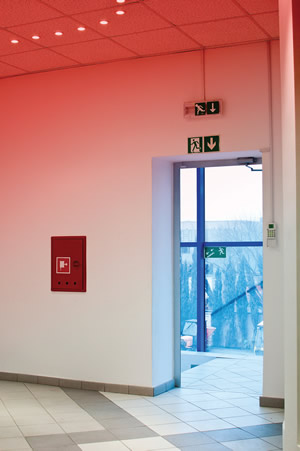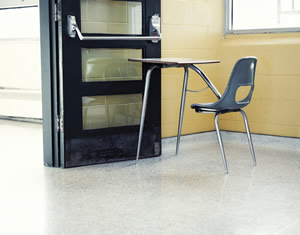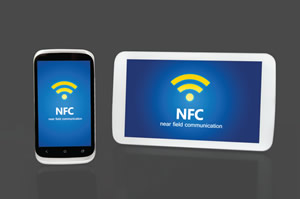Safety & Security (Prepare and Be Aware)
Access Control Goes To High School
- By Michael Fickes
- September 1st, 2016

PHOTO © ANTOS777
Between 2013 and 2015,
there were 84 shootings in K-12
schools, according to Everytown
For Gun Safety, a research organization
that tracks gun violence.
The U.S. Department of Education says
that about 15 students die at school from
gunshot wounds every year.
Thefts and assaults are also problematic
in schools. In 2012, for instance, there were
more than 1.3 nonfatal victimizations of
students aged 12 to 18, according to the
National Center for Education Statistics.
The Center did not note how many of those
victimizations were committed by outsiders
that entered the school. There can be
little doubt, however, that outsiders were
responsible for some meaningful share.
In response to these kinds of violent
incidents, school security directors are
working to tighten up security, especially
access control security that can keep
outsiders out and perhaps prevent some
violent incidents inside.
Randy Braverman is director of campus
safety at Oak Park and River Forest
High School, district 200 in Illinois. It
is a huge school with 7,500 students and
one million square feet of buildings and
property.
“I’ve been here for four years, and
we’ve put together a good safety program,”
Braverman says. “We have 34
security officers and a school resource
officer (a police officer assigned to the
school).
“We meet with representatives from the
police and fire departments monthly to go
over fire and security issues.”
The school drills with both the fire and
police departments regularly, covering
actions such as evacuation and hard lockdown.
“We drill both police and fire on the
same day so both departments are here,”
Braverman says.
Access control, of course, plays a significant
role in Braverman’s wide-ranging
security program.

PHOTO © STACEY NEWMAN
Alarming. School security directors are continually working to tighten up
security, especially access control to keep outsiders out and prevent some
violent incidents. Access control is a wide-ranging security program, which
includes technology that carries out hard and soft lockdowns, to propped
door alarms and school-wide card swipe access systems to provide firm
control over who can come and go.
“I think the biggest access control
challenge in K-12 schools involves keeping
students from propping doors open and
letting outsiders in,” Braverman says. “We
have to train everyone about this. If you see
a door propped open, close it and report it.
“If a person you don’t know wants to
come in, don’t let him or her in.”
Braverman has security officers on
patrol outside looking for propped doors and people that don’t belong on the property. “It’s important for
security to know who is on the property,” he says.
He has also installed an access control system that covers all
the doors. “An alarm goes off when a door is propped open,” he
says. “We want everyone to swipe in and out. If a door opens without
a card swipe, an alarm goes off and my phone and all of the officers’
phones receive an email and text to check the door. We also
have cameras watching the doors and who is coming in or out.”
At the main entrance in the front, Braverman has installed
a front entrance trap. When a visitor enters the trap through
the unlocked outside door, an officer speaks to the individual
through a window asking for the individual’s driver’s license or
other photo ID. The officer also asks questions about the nature
of the visit, while checking a list of known sexual predators and
another list of court orders prohibiting visits from parents. If the
interview and checks pan out, the visitor receives a badge that
says clearly this is a visitor. Teachers will stop anyone without a
visitor’s badge.
“We keep the individual’s driver’s license,” Braverman says.
“That ensures he or she will come back to check out, letting us
know the person is no longer in the school.
“Again, we need to know who is in the building. It isn’t just to
keep people who shouldn’t be in the building out. If there is a fire
or some other kind of emergency that causes us to evacuate the
building, we have to know who the visitors are to make sure they
get out.”
NEW ACCESS CONTROL ATTRACTIONS
 Now you can use a technology called near field communications
(NFC) to enable smartphones, tablets and other mobile devices to replace
smart cards or keys.
Now you can use a technology called near field communications
(NFC) to enable smartphones, tablets and other mobile devices to replace
smart cards or keys.
The solution requires NFC enabled phones and apps as well as NFC
readers and an NFC identity management system.
HID Global has been providing these systems for several years. With
that system, users download an app to their phones and register the app.
The system administrator then issues mobile IDs.
The advantages of NFC include replacing access cards and the hassles
they cause. Students always lose access cards, which can be expensive and
time consuming to replace. Very few students lose their phones, and when
they do, the responsibility for replacing a phone falls to the owner.
The phones can also be disabled remotely from the administrative
office should you need to bar someone from the facility.
For users that don’t have smartphones, smartcard’s can be enabled to
access NFC-controlled doors.
The various communications that include confidential user information
can be encrypted to ensure privacy.
Tightening Up
Has Braverman tightened up the system in response to recent
shootings and other violent events in schools?
“Every year, we review the program and look for ways to
tighten,” he says. “But we check constantly to make sure all of the
equipment is working. Do the alarms go off when they should? Are
the locks working? We test all of them.
How about the public address system? At the beginning of
every year, Braverman sends messages over the public address
system and then asks teachers if they heard the messages.
Braverman has automated technologies that he puts through
the paces, too. “I have a software program that executes a hard
lockdown at the push of a button,” he says. “Numerous things happen
all at once: The outside doors automatically lock, and no one can get in. All the access control readers shut down for all cards
except those held by police officers.
“We also have red strobe lights in the pools, gyms and band
areas. So if teachers don’t hear the lockdown message, they see this
message to go into hard lockdown.
There are red strobe lights outside around the school. Those tell
people to stay away from the school in an emergency.
Finally, an automated message goes to the police station.
“We also have a soft lockdown procedure,” Braverman says. “If
a danger in the community might come our way, we ask the gym
classes and any other classes being held outside to come in. We
make sure the doors are locked. The teachers continue to teach,
but no one moves around the building – just in case we would need
to go to a hard lockdown. An automated public address announcement
sets the procedure in motion.
“I like pre-recorded messages. In an emergency, people are nervous.
They may not be sure about what to say. In addition, voices
can be nervous. Our automated messages play in a calm voice.
From technology that carries out hard and soft lockdowns to propped
door alarms and the school-wide card swipe access system, Braverman
has taken firm control over who can come and go at Oak Park.
That’s the way it has to be in our day and age.
OAK PARK COMMUNICATIONS TECHNOLOGIES
Communication technologies support access control. “We’re always
looking for good communications technology,” Braverman says. Right now,
we’re considering a communication device that works with two-way radios.
Our radios go into a base system and override others in case of emergency,
but sometimes you can’t get through.
“The system we’re looking at uses a control device that communicates
through sensors located around the building. With this system,
a security person could report an emergency by hitting a button to
override other communications and asking for help.
“We’re always looking for good technology. We have to have good
radio communications so we can respond as quickly as possible to calls
for help.
“And we test it constantly. For instance, we once had to install
new repeaters in our building after the police and fire departments
tested their ability to communicate in our school, and they couldn’t
communicate well enough. Last year we put in a new system, and
now any emergency responder can talk to fire fighters, police officers
and us.”
This article originally appeared in the September 2016 issue of School Planning & Management.